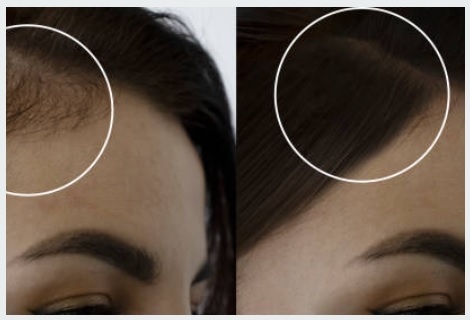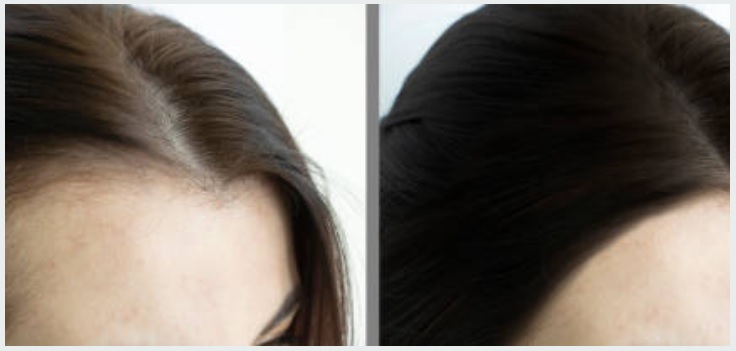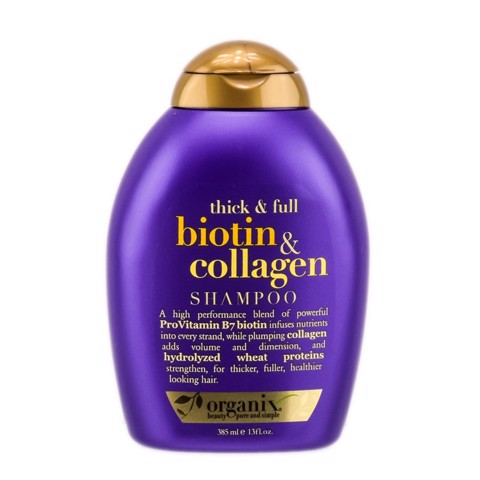
My Hair Loss Story: How I managed to stop hair loss, and regrow my hair, safely and naturally.
Hair loss was never an issue for me during my early adult years. I remember having long, thick, luscious hair throughout my 20s, and I guess you could say my locks were one of my best features.
Even at 30, I didn’t see the signs. My hair looked as thick as it had ever been, and there was no evidence of excessive shedding. I was happy with my hair, and I felt good about myself. But then, in what seemed to be in an instant, I noticed my hair starting to take a turn, for the worst.
My Hair Loss Story
Hair loss was never an issue in my family. My mother has always had good hair, and so too has my older sister. Even my father still has a relatively good head of hair, and he’s in his 70s now. Hair loss wasn’t something that I ever worried about, and it was something I never felt like I needed to worry about.
As I went into my 30s, all seemed fine with my hair, but then, at around the age of 32, I started noticing an excess amount of hairs on my pillow in the mornings, as well as in the plug hole after I had showers. I even started noticing more hairs on my hairbrush after brushing.
I also started to see my frontal hairline getting thinner, with slight recession. This was hugely concerning, and I needed to take some immediate action.
Having researched the issue, I thought it might be a case of seasonal shedding – a temporary process whereby the hair thinnens and falls during certain times of the year. It’s a hair loss phase, but the hair usually grows back once the phase has passed.
But having not experienced seasonal shedding before, I wasn’t convinced that this was the issue, so I decided to see a trichologist, in the hope that they’d be able to diagnose the problem, and treat it.
Female pattern baldness
After seeing my trichologist, it turned out I was experiencing early stages of female pattern baldness, otherwise known as androgenic alopecia. I wasn’t an expert in hair loss by any stretch of the imagination, but I was pretty familiar with this term, and it didn’t sound good at all.
The problem with female pattern baldness is that it is a temporary hair loss type, therefore, unless treated effectively, it is continuous, and will lead to eventual baldness.
Seasonal shedding, as well as post pregnancy thinning, are examples of temporary hair loss types, which means, with or without treatments, the hair does eventually go back to its healthy growth cycle, once the shedding phase has passed. Female pattern baldness, though, is a long, progressive process.
I thought I would be immune to genetic hair loss, as there is no history of androgenic alopecia in my family, however, all it takes is one unlucky gene, and the family trend can be broken, and this certainly seemed to be the case, with me.
Treating hair loss safely and effectively
If I’m honest, I was distraught about the whole situation. It felt like the most confidence-damaging, soul-destroying thing I could ever go through. Losing your hair is like losing a big part of your identity, and this honestly felt like the worst thing I had ever experienced.
However, that’s not to say I gave up, because I didn’t. I am a positive person by nature, and I am very determined, too. I was willing to try and fight this issue, and find some sort of solution.
The good news was that I was going through early stages of hair loss. It’s a good job I saw the trichologist as soon as possible, because like with any hair loss type, the earlier you act, the better chance you will have of tackling the issue.
Now that the cause of my hair loss had been identified, it was time to assemble a treatment plan. Realistically, my main objective was to slow down and halt the thinning. Once that could be achieved, I could then look at potential ways of re-growing as much of the lost hair as possible.

My hair loss treatment plan
My trichologist went through some treatment options with me, listing all the pros and cons of each treatment. To be fair, there aren’t actually that many effective treatments for androgenic alopecia, but it was still important to select the right ones that would work best for me, individually.
So, having gone through the main treatment options with my trichologist, I decided on some safe and natural options. I had the option of using medical treatments like minoxidil (Regaine), but I wanted to avoid using anything that could give me negative side-effects. I have always been into my health and fitness, and I am conscience about what goes into my body, therefore, as important as my hair is to me, I would never want to compromise on my health and wellbeing.
After much consideration, I decided on simple treatment plan that was both safe and effective. My treatment plan consisted of five main products.
HR23+ Hair Supplement
Good supplementation is absolutely vital for hair health, and so the first thing my trichologist suggested was to take a multivitamin hair supplement. Now, multivitamins do not cure hair loss, but they can help slow down and halt the excessive shedding, and support the function of healthy hair growth.
Not all multivitamin hair supplements are effective, but there are some good ones on the market like Viviscal and Nutrafol, for instance, but I decided to go for HR23+, on the recommendation of my trichologist, and on the basis of its reviews and popularity.
Did it work? To my amazement, I started noticing visible improvements in my hair within just weeks of taking HR23+. The excessive shedding slowed down dramatically, and my overall hair growth looked thicker and healthier. This wasn’t a miracle formula, but even so, it was more than I could have hoped for, especially this early into my treatment plan.
Keratinocyte Growth Factor (KGF) Serum
Because I wanted to avoid using minoxidil, my trichologist suggested a safe alternative. So, I started using Keratinocyte Growth Factor (KGF) Serum, once a day, around 3-4 times a week. KGF is a DIY active ingredient that can help promote the function of healthy hair growth by utilising the nutrients that contain prebiotics, polysaccharides and antioxidants to protect the cells that make hair.
Did it work? Much like with the supplement, the KGF serum started working within the first few weeks. I noticed less hair fall, and a fuller texture to my locks. I started using the serum about a month after I started on HR23+ supplement, as we wanted to test the results from each product individually.
Biotin & Collagen Shampoo
Shampoos do not treat hair loss, but they can work well in conjunction with treatments, and compliment a hair care plan. My trichologist advised me to use a high-protein shampoo that contained key ingredients like biotin, collagen, keratin, and argan oil, to name a few.

I normally use OGX Biotin & Collagen shampoo, but to be honest, the whole OGX range is very good. These shampoos lather well, and give the hair extra thickness and texture, which is always a welcome thing, in my book. Some other shampoos that I use from the OGX range are the Moroccan Argan Oil shampoo, the Cocoanut Oil shampoo, and the Keratin shampoo.
Scalp Massage Shower Brush
Massaging the scalp can help boost blood circulation, which is absolutely critical for hair follicles to thrive, therefore I decided to use a scalp circulation shower brush on a regular basis.
The hand-held massager, which can be purchase from Amazon for as little as £5, helps increase blood flow for strong, healthy hair. I massage my scalp with the OGX shampoos, and I must say, my hair has benefited hugely from it.
Micro Needling
One thing that took me by surprise, from speaking to the trichologist, was micro needling. I was informed that, by piercing lots of tiny wounds into your skin, it could produce hair growth during its recovery. The tiny punctures stimulate and increase collagen production, thus erasing wrinkles, age spots, scars and so on, the process stimulates the hair follicles in your scalp, encouraging stronger, and even new, growth.
Derma rollers and derma stamps are the cheapest devices to use for micro needling. I use a 0.5mm derma roller, around twice a week. I roller the pins across my frontal hairline, in two directions.
Does it work? It took about six months to start seeing some results, but I did eventually see some baby hairs sprouting across my frontal hairline, which has been hugely positive. I look forward to seeing the progression of this treatment going forward.
Is my hair loss treatment plan effective?
I started experiencing noticeable hair loss when I was 32. I am now 35. I have been treating hair loss for more than three years, and overall, I would say it’s been a success, so far. I have managed to prevent the excessive hair fall, and I’ve stabilised my hair, somewhat. I am also experiencing fuller, faster hair growth, which is of the same pattern I was experiencing when I was in my 20s.
There are a few main reasons why I have been able to treat my hair loss effectively. If I am to give advice to other women suffering from hair loss, like I have done, then, first and foremost, I would strongly suggest doing these three things.
Know your hair loss type
Diagnosing your hair loss type is the most crucial part of your treatment plan. If you do not know what is causing your hair loss, then you will struggle to assemble the right treatment plan that will work for you.
There are many hair loss types, especially in women. Your hair loss type could be seasonal, postpartum, menopausal, stress-related, or genetic. So, once you accurately identify what is causing your hair to fall out, you’ll then be better placed to treat the issue.
Act quickly
It’s so true what they say; the quicker you act, the more chance you will have of holding onto your hair for longer. Many women (and men) do not do something about their hair loss until it’s too late. Hair loss can be highly aggressive, therefore you should look to treat the issue as early as possible.
Slowing down the rate of hair fall is realistic, so the more hair you have, the more hair you’ll save.
Be decisive
When it comes to treating hair loss, you’ll need to settle on a treatment plan quickly. Be sure to speak to a trichologist about treatments, and then once you’ve got an idea of what’s available, be decisive in your decision making, and assemble your hair care plan.
Decide on what treatments you want to take, and which ones you’d prefer to avoid. For me, personally, I only wanted to use safe and natural treatments, but I completely understand if other women would want to risk using medical treatments. The choice is yours, but be decisive, either way.


Minaxi Dhokia
Hi ,thank you .I’m going through a lot of hair loss in the front part of my fore head.I have frontal alopecia fibrosis. How do you know which tritrochologist to see ?